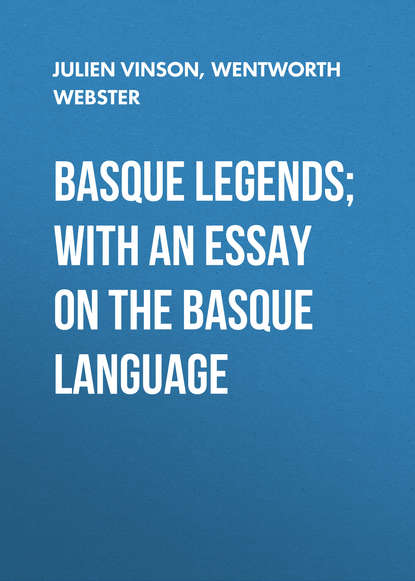По всем вопросам обращайтесь на: info@litportal.ru
(©) 2003-2024.
✖
Basque Legends; With an Essay on the Basque Language
Автор
Год написания книги
2018
Настройки чтения
Размер шрифта
Высота строк
Поля
In order to go to the mountain, she was dressed in her most beautiful robes. She had seven of them on. He took a little piece from each of the seven robes, and he likewise takes the tongue from each of the heads, and puts them in these little pieces of silk. He then takes the king’s daughter on his horse, and descends the mountain. The daughter goes home to her father, and our gentleman to the bear’s house. The news that the seven-headed serpent is killed spreads quickly. The king had promised his daughter, and the half of his kingdom, to the man who should have killed him. The serpent was killed, as we have said. Three charcoal-burners, passing by on the mountain, see the serpent, and take the seven heads, and go to the king, asking to have a reward. But, as they were three, they were in a difficulty; and they were sent away until the council was assembled, and to see if any other person would come. As nobody appeared, they were going to draw lots who should be the husband of the king’s daughter. There was great excitement that day, and there was also a great stir when this young man arrived in the city. He asks what it is. They tell him what it is. He was splendidly dressed, and had a magnificent horse. He asks to see the king, and, as he was handsomely dressed, he is received immediately. He asks if the seven heads of the serpent had seven tongues in them; and they cannot find them. Then he shows the seven tongues. He sends, too, for the princess’ seven robes, and he shows the seven pieces that are wanting, as well as the seven tongues. When they see that, all exclaim—
“This is the true saviour of the king’s daughter!”
And they are married.
The three charcoal-burners, after having been dressed in a coat of sulphur, were burnt alive in the midst of the market-place.
Our gentleman and lady lived very happily, sometimes at her father’s house and at other times at their own bear’s-house; and, as they had lived well, they died happily. Then I was there, and now I am here.
Our next tale will show the serpent in a new character, and might have been included under the variations of “Beauty and the Beast.”
The Serpent in the Wood
Like many others in the world, there was a widower who had three daughters. One day the eldest said to her father, that she must go and see the country. She walked on for two hours, and saw some men cutting furze, and others mowing hay.
She returned to the house, astonished at having seen such wonderful things. She told her father what wonderful things she had seen, and her father replied:
“Men cutting furze! Men mowing hay!!”
The second daughter asks, too, to go like her sister, and she returned after having seen the same things. And the third daughter said that she ought to go, too.
“Child, what will you see?”
“I, like my sisters, something or other.”
She set off on the same road as the others; and she, like the others, saw men cutting furze, and men mowing hay. She went on further, and she saw some washerwomen; and she went still a little further on till she had walked for three hours, and she saw some wood-cutters cutting firewood. She asked them if she should see anything more if she went a little further. They told her that she would see some more wood-cutters cutting firewood.
She went very much farther into the wood, and she was caught, and kept prisoner by a serpent. She remained there crying, and not able to eat anything; and she remained like that eight days, very sad; then she began to grow resigned, and she remained there three years. At the end of three years she began to wish to return home. The serpent told her to come back again at the end of two days; that his time was nearly finished, and that he was a king’s son condemned for four years[34 - Cf. “Mahistruba,” p. 100; and “Beauty and the Beast,” p. 167.] (to be a serpent). He gave her a distaff and spindle, of silver-gilt, and a silk handkerchief. He said to her:
“If you do not find me here on your return, you will have to wear out seven pairs of shoes, six of leather and one pair of iron ones (before you will be able to find me).”
When she came home, her father would not let her go back to the house where she had passed such a long time with a son of a king, condemned to be a serpent. She said that his time was almost finished, and that in gratitude she ought to return; that he had said that he would marry her. The father had her put in prison, confined in a room very high up. The fourth day she escaped, and went to the place, but she did not find the king’s son. She had already shoes on her feet. She had almost worn them out. After that she bought another pair. She kept journeying on and on, and asking if it were far, and they told her that it was very far. She bought still another pair of shoes, and these, too, got worn out on the road. She bought a fifth pair, and after them the sixth also. She then asked if she were near yet, and they told her that she was still very far. Then she bought the seventh pair of shoes, of iron. And when she had gone a short way in these shoes, she asked if it were far from there to the son of the king. The seventh pair of shoes were almost worn out when she came to a city, and heard sounds of music. She inquired what was happening in the city.
“Such a king’s son is being married to-day.”
She went to the house, and knocked at the door. A servant came.
“What do you want?”
She asked if there were any work to spin, and she would spin it.
And the servant went to tell it to the mistress. The lady ordered the servant to bring her in. She brought her in. And when she was in the kitchen, she showed the silk handkerchief which the king’s son had given her; and she began to blow her nose with that. The lady was quite astonished to see the girl blow her nose with such a beautiful handkerchief, as if it were nothing,[35 - Silk kerchiefs are generally used, especially by women, as head-dresses, and not as pocket-handkerchiefs, all through the south of France.] when her son had one just like it for his marriage-day. So she told her son, when he came back from the church, that she had a spinster who came from a great distance, and said to him:
“She has a silk handkerchief just like yours!”
And the king’s son said to his mother:
“I, too, must see this spinster that you have there.” And he began to go there.
And his mother said to him,
“But why must you see her?”
“I wish to see her.”
He went to the kitchen, and in his presence she used her silk handkerchief.
He said to her,
“Show me that.”
She said to him,
“It is too dirty to put into your hands, sir.”
The gentleman says to her,
“I wish to see it, and show it to me.”
(Then) he recognised the young girl. She showed him (too) the distaff and spindle.
At table, when everybody was engaged telling stories, this king said:
“I also have a story to tell.”
Everybody was silent, and turned to look at him, and he said:
“Formerly, I had a key to a chest of drawers, and I lost it, and had a new one made. (After that, I found the old one.)”
And he turned to his wife:
“Should I use the old one or the new one?”
And she replied:
“If the first was a good one, why should you make use of the new one?”
Then he gave her this answer:
“Formerly, I had a wife, and now I have taken you. I leave you, and take the former one. Do you go off, then, to your own house.”
Gagna-haurra Hirigaray.
(Learnt at Guethary.)
For the version of the Heren-Suge tales which most closely approaches the Gaelic, see below, “Keltic Legends,” “The Fisherman and his Sons,” p. 87.
III.—Animal Tales
Другие электронные книги автора Wentworth Webster
Spain




 0
0






